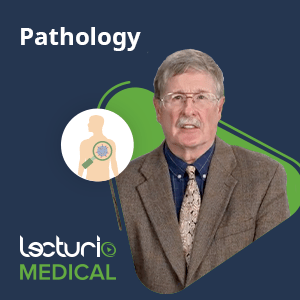Before, you had to learn how the body works in physiology and anatomy. This time, we learn about what can go wrong in the human body and there’s a lot that can go wrong. To make things even harder, you’re expected to know how to diagnose disease and treat it. Knowing all that, it can sound overwhelming and feel intimidating to start studying. There are a lot of systems and not enough time. Whether you choose to supplement your studies with the Lecturio online course in pathology to guide you through or not, hopefully, by the end of this article, you’ll feel better equipped to fight the upcoming battle that is pathology!
What is Pathology?
In the simplest terms, it’s the study of causes and effects of disease on your body.
Basically, it’s where basic science meets medicine. You’ll be putting everything you’ve learned before to the test. While it’s a lot to learn, the fact that the subject comes up often in medicine makes it a bit easier to remember.
That said, if there’s a subject you must master, it’s pathology. Why? If you don’t understand the cause of a disease, how can you expect to treat it? Sure, following standard practice is good, but when your patient comes in with multiple diagnoses you’ll need to figure out how the diseases interact and affect the patient overall. Remember, symptoms are explained by the pathology of the disease. So once you see a patient has specific symptoms, it’ll be easier to identify the underlying pathology.
Is Pathology Hard?
Yes. I won’t sugarcoat anything. pathology is hard. You have to use a lot of concepts from previous subjects like anatomy, histology, physiology, biochemistry, etc. So if you have forgotten any of those concepts, you might have a hard time following pathology. Of course, you can always go back to the basics, but it’s better if you’ve mastered them by now.
Also, there are a ton of diseases for you to master. For any medical student, it can seem like an exciting prospect. That is until you realize how many there actually are. You’ll learn the causes of things, from stomach aches to losing consciousness. It’s pretty much what your family and friends will ask you as a medical student. It’s what your patients will ask you when you become a physician. In other words, you need to know what you’re talking about when people ask.
Take the Course: Pathology
Become a master of pathology with Dr. Mitchell from Harvard Medical School.
Pathology Tips and Tricks
#1: Master the basics
I have mentioned it a lot already, but this is really important.
You will need a firm understanding of everything about the body, even down to the cellular level.
As you study, ensure that you have some quick references on hand. It can be your old notes, a book, or even the Lecturio physiology courses — as long as it’s something you can use to refresh your memory on concepts you may have forgotten.
You might think that recalling the basics is hard, and it is, at first. Actually, you’ll find the basics easier to recall because you’ll repeatedly encounter them throughout this subject. At some point, your understanding of physiology and pathology will click together. Before you start on any pathology subject, try to brush up on related topics. That way, you get used to basic sciences and pathology going hand-in-hand. For example, if the subject is cardiology, go back to the basics of blood flow, heart chambers, and heart muscle histology. It’s hard to know what’s wrong when you don’t know what’s normal in the first place.
#2: Find the right resources
Whatever you usually use, make sure your resources are easy to understand. For example, many schools prescribe Robbins Basic Pathology as the main reference. In fact, that’s also what I used. However, for some, it’s a lot of information to sift through, and not all students can do that efficiently.
Instead, use references you can understand. Lecturio has a good schedule for studying pathology. It’s organized and tells you in which parts of First Aid you can find the subject. So if you’re looking for an organized way to study, you can try this course. Otherwise, there are apps you can use. Personally, I used to use UpToDate for my quick reference during rounds.
Related videos
#3: Use pictures
Much of pathology, especially pathology lab, is going to be visually based.
You’ll be asked to know what various diseases look like under a microscope. What do glomerular crescents look like? What makes fatty necrosis different from caseous necrosis? What makes hypertrophy different from hyperplasia?
For this purpose, I suggest you have a browser open and ready to search for photos. You’ll have to learn to identify diseases by both microscopic and gross manifestations. This is also how you remember characteristic lesions such as dewdrop on rose petal rashes in chickenpox or starry sky patterns in Burkitt’s Lymphoma. Why learn these silly-sounding names or look at pictures? It’s because phrases like sheets of pale eosinophilic cells with distinct borders and perinuclear halos are hard to remember.
Studying medicine has never been easier.
Set yourself up for success with Lecturio.
#4: Look at flowcharts
Apart from pictures, you need to learn through systems.
All organ systems are related to each other. Always keep this in mind: The body always tries to keep itself in equilibrium. If one system goes wrong, another will try to compensate. For example, when you lose blood, your heart beats faster to get more blood to organs and you breathe more to increase oxygen. Baroreceptors in your vessels can detect decreased blood flow and cause vasoconstriction.
Try to draw the effects in flowchart form, so that when you recall them, you know the next steps the body will take in response to an injury. This works even better when you try to learn the disease effects based on symptomatology. Always ask yourself, “Why?” When a patient comes in with heart failure, why do you hear an S3? Why is there excessive sweating? Why does the patient have edema or decreased urine output? If you can figure out the root of those problems, learning how to treat them becomes easier.
#5: Explain it in your own words
Pathology is complicated and wordy.
Sometimes it takes me two or three reads to understand. Other times, I skip the wordy parts, no matter how important it is. I realized explaining pathologic processes in my own words makes it less intimidating. What I’m learning becomes more simplified, and I recall it better. This is especially helpful when I compare and contrast different diseases that seem similar.
However, the big downside is that it oversimplifies complicated diseases. For example, you may have learned that type 1 diabetes mellitus is where there’s no insulin made; meanwhile, type 2 is where there’s insulin, but the body can’t use it. However, that’s not necessarily the case. Insulin resistance is a part of type 2, but the full extent of the disease happens when there’s an imbalance between insulin levels and sensitivity. So, be careful when simplifying disease concepts.
#6: Memorization techniques
Of course, we can’t ignore the power of trusty mnemonics and word associations. While it’s not always efficient, some memory aids stick better than others. For example, we have “Blue Bloaters and Pink Puffers” for chronic bronchitis versus emphysema. We also have 6Ps for Compartment Syndrome or “MUDPILES” for causes of high anion gap metabolic acidosis. To make it stick better, you can use spaced repetition, with which you can create associations to make these concepts faster to recall each time.
Pathology Lab and Surviving it
Now, we’re going to talk about your laboratory classes. Reading books and listening to lectures is hard, but your lab class is a different ball game. You’ll have slides you can browse on your own, and you’ll likely be given a workbook to guide you. Some schools even have moving exams to test your practical and textbook knowledge. So following are a few tips to get you through it, relatively unscathed:
Making the most of pathology lab
Take pictures, draw, and label. Similar to my tips in anatomy, drawing and labeling can improve your recall of various structures. I would also suggest using colored pencils because colors can point to particular pathologies. For example, heart failure cells have a characteristic brown pigment in contrast to the surrounding myocytes, which are usually pink.
You also need to label the normal parts you see on your slide. This works even better if you have a normal organ or slide for reference while you study. Always take the time to compare what your slide looks like in contrast to normal findings.
Look at your classmates’ slides. Don’t get too accustomed to what your slides look like. Similar to “Passing cadaver lab”, you should look at other slides, too. You can ask your classmates to help if you can’t find what you’re looking for. Honestly, everything is faster if you work together. In medical school, my laboratory roommates decided to make a little “gallery” of everything we had to find. Next to each microscope, we also had descriptions on our laptops. That way, we would know what we were looking at.
Ask questions. Lab sessions are when the professors are available to teach. Of course, you’re supposed to figure things out for yourself first with a workbook. However, whenever there’s something you don’t understand, don’t be afraid to ask questions.
Attend the diagnostics sessions. In the pathology lab, we had to learn to do diagnostics like fecalysis, semen analysis, blood smears, and other procedures that can be done under a microscope. These procedures always come out in our exams, so it’s better to learn by doing in these cases rather than simply reading them off the handout.
Passing your moving exam
Moving exams are not found in all medical schools. However, I think it’s worth mentioning for students with practical or moving exams. This exam format is more hands-on than your written exam. You’ll have to identify things under the microscope or grossly, or even walk through the steps of a diagnostic procedure. All of this is done with a time limit. It sounds like a lot of pressure, but with good preparation, it’s doable.
Before you even start, study more than just what’s in your workbook. Sure it’s a test about your pathology lab, but if your school is anything like mine, they’ll put in questions from textbooks, too. They won’t always ask you questions like “What’s this structure?” Instead, be prepared to tackle two-step or even three-step questions.
In the exam, read the question and choices (if any) first. It’s better if you know what you’re looking for when you look through a microscope. Sometimes the question already hints at what the slide is showing. So that saves you a lot of time trying to figure out what you’re looking at.
Next, identify which organ you’re looking at! It sounds easy to remember what a muscle or a kidney looks like. But if you’re looking at a fatty liver, it doesn’t look like liver tissue anymore. Once, I thought I was looking at skeletal muscle when I was actually looking at a leiomyoma in the uterus. It sounds like a funny mistake, but it happens more often than you think. Plus, when you’re under time pressure, making mistakes is common.
With all this in mind, pathology is a different monster from the subjects you’ve previously faced. The books have pictures, and it’s still hard! So, prepare yourself, but don’t forget to enjoy it. There were parts of pathology I loved (i.e., oncology) and others that I wish I didn’t have to learn. But it’s all a part of your journey as a doctor. It’s a complicated subject that leaves many patients in the dark. Learning about a disease is scary because patients don’t understand it. It’s your job to enlighten them and help them through that process. At the end of the day, it’s always for them, anyway.





